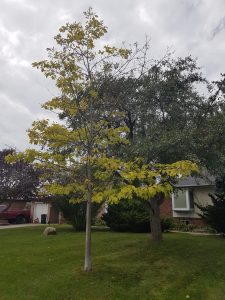
Hi,
I asked the city (Toronto) to plant this tree back in 2005. For the last three years it has been losing branches and now it is about 50% dead. Right from the spring time, the leaves are yellowish and not that nice green color. Every year it is losing more branches/leaves. The first two years, the city told me there is nothing wrong with it. Now they are saying it should be cut down.
What can be done, if anything? I do not always get the chance to listen to your show as I could be working. I listen to it sometimes on my way home. So a brief email response would be appreciated.
Our soil is clay.
It is impossible to tell with certainty from your photograph but your tree’s silhouette suggests that you may have a red oak, Quercus Rubra. The City of Toronto plants several species of oak trees. Your clay soil should not be a problem for this species, or for oaks in general, but your soil’s pH level (its acidity or alkalinity) may be the reason your tree is not thriving. Some oaks – pin oaks and red oaks, for example – do not do well in soils with a high pH level, i.e., in soils with high alkalinity.
There are many reasons that relatively newly transplanted trees may fail to thrive. But the yellowing leaves may indicate that your oak tree is suffering from iron chlorosis, in which the yellowing of the leaves is caused by an iron deficiency in the soil. A deficiency in iron, and to a lesser degree manganese, can occur in soils which are alkaline , i.e., with pH level above 7.0. In severe cases iron chlorosis can severely weaken the tree and can lead to dying off of branches and eventually death. Leaf yellowing can also be due to insect or disease problems caused by fungi or other organisms. The Urban Forestry staff who assessed your tree will have considered all these factors before making a determination.
You could have your soil pH tested to determine its acidity/alkalinity. Kits for soil pH testing are readily available in garden centres. The optimal pH range for most plants is a soil with slight acidity, i.e., between 5.5 and 7.0 (with below 7 acidic and above 7 alkaline). This would at least let you know whether an alkaline soil may be a contributing factor. However, the City of Toronto’s guidelines to tree assessment seem to be quite clear:
“It is the City policy to assess each tree separately. Where a City tree can no longer be maintained in a viable state due to structural defects, being dead, or in a state of severe and irreversible decline, it will be scheduled for removal. A replacement tree will be scheduled for planting, where a viable planting site exists.” https://www.toronto.ca/311/knowledgebase/kb/docs/articles/parks,-forestry-and-recreation/urban-forestry/city-policy-for-replacing-dying-trees-on-a-city-road-allowance.html
It may be worthwhile for you to speak again with one of the City’s Urban Forestry staff members as to whether there is a better species of tree for your lot. Here is a link to the website which includes available species, contact information, etc.: https://www.toronto.ca/311/knowledgebase/kb/docs/articles/parks,-forestry-and-recreation/urban-forestry/tree-planting-on-city-property-by-urban-forestry.html

